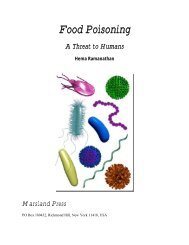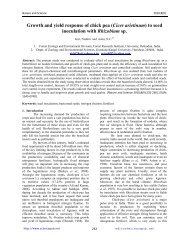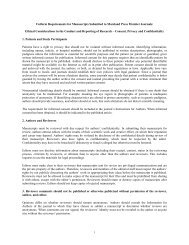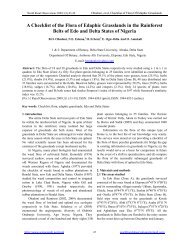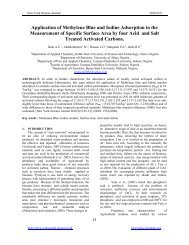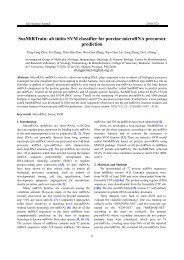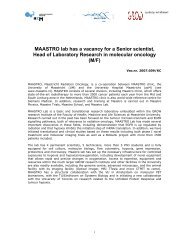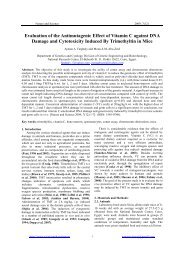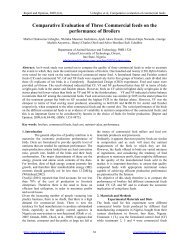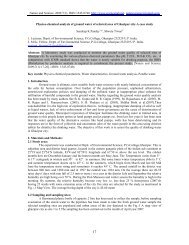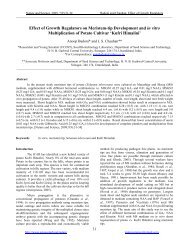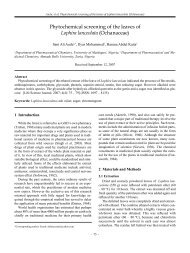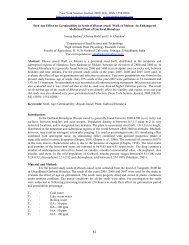Ecological, Social and Commercial Role of Lichens in India with ...
Ecological, Social and Commercial Role of Lichens in India with ...
Ecological, Social and Commercial Role of Lichens in India with ...
You also want an ePaper? Increase the reach of your titles
YUMPU automatically turns print PDFs into web optimized ePapers that Google loves.
Acdemia Arena 2010, Supplement 0201<br />
http://www.sciencepub.net<br />
& shape <strong>of</strong> tree, age <strong>of</strong> tree, <strong>and</strong> climate <strong>of</strong> the region. The Quercus semecarpifolia is an excellent<br />
phorophyte to provid<strong>in</strong>g much lichen mass due to dome shaped canopy.<br />
In both the cases the phorophytes Q. semecarpifolia <strong>and</strong> R. arboreum, more than 70% mass <strong>of</strong><br />
major epiphytic lichens was contributed by the canopy twigs <strong>and</strong> rema<strong>in</strong><strong>in</strong>g 30% lichen mass<br />
contributed by tree branches <strong>and</strong> trunk or bole at both the aspect <strong>of</strong> the forest.<br />
The youngest trees <strong>of</strong> Q. semecarpifolia have found as good lichen mass due to the age<br />
trees <strong>and</strong> smoothness <strong>in</strong> the trunk bark <strong>and</strong> absence <strong>of</strong> growth <strong>of</strong> other epiphytes, <strong>and</strong> <strong>in</strong> case <strong>of</strong><br />
sapl<strong>in</strong>g (dbh1-30cm), all the parts <strong>of</strong> the sapl<strong>in</strong>gs (<strong>in</strong>clud<strong>in</strong>g trunk, branches <strong>and</strong> twigs) were<br />
contributed for lichen mass. In case <strong>of</strong> <strong>in</strong>creas<strong>in</strong>g diameter (dbh>31cm), the twigs also provided<br />
good lichen mass as compared to tree branch <strong>and</strong> trunk or bole.<br />
The Usneaceae family is represented <strong>in</strong> about more than 60% at southeast aspect <strong>and</strong> 58.26%<br />
lichen dry mass at northwest aspect <strong>of</strong> the forest. The Parmeliaceae family also represents 26.19%<br />
<strong>and</strong> 25.54% lichen dry mass at southeast <strong>and</strong> North West aspect. In both the forests Ramal<strong>in</strong>iaceae<br />
family is represents as very poor contribution about 2% <strong>in</strong> open <strong>and</strong> 3% <strong>in</strong> closed canopied forest.<br />
In open canopied forest (southeast aspect) <strong>and</strong> closed canopied forest (northwest forest) the<br />
fruticose lichens provided 46.4% <strong>and</strong> 26.84% dry mass <strong>of</strong> lichens, this contribution is grater than<br />
dry mass <strong>of</strong> foliose lichens as 27.94% <strong>and</strong> 27.36% dry mass <strong>of</strong> lichens.<br />
Accord<strong>in</strong>g to Degelius (1978) the lichens began to colonize oak twigs <strong>in</strong> Europe at about five<br />
years. Stone (1989) reported that branches <strong>of</strong> Quercus garryna upto twenty year old show growth<br />
<strong>of</strong> many foliose <strong>and</strong> fruticose lichens. Similar to the studies it was observed that on mature Quercus<br />
semecarpifolia, Q. floribunda, <strong>and</strong> Q. leucotrichophora trees <strong>in</strong> <strong>and</strong> around the study area<br />
atta<strong>in</strong>ment <strong>of</strong> the climax stage was exhibited by dom<strong>in</strong>ance <strong>of</strong> foliose <strong>and</strong> fruticose lichens<br />
represented by Ramal<strong>in</strong>a <strong>and</strong> Usnea species. Dudgeon (1923) mentioned six stages <strong>of</strong> succession<br />
on epiphytic lichens <strong>of</strong> Quercus leucotrichophora. The crustose lichen stage, beg<strong>in</strong><strong>in</strong>g <strong>with</strong><br />
numerous little patches <strong>of</strong> crusts as pioneers on the bark <strong>of</strong> branches that were 3-4 year old, <strong>of</strong><br />
which two species frequency wise represent about 75% <strong>of</strong> the total vegetation. Foliose <strong>and</strong><br />
fruticose lichens appear simultaneously but become somewhat conspicuous, 3-4 years old Usnea<br />
barbata (=Usnea complanata: Mull. Arg.Mot.) was a prom<strong>in</strong>ent member. This stage under<br />
favorable condition takes about 9-12 years to achieve its full development. The later stage <strong>of</strong><br />
67




